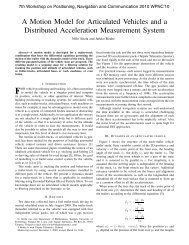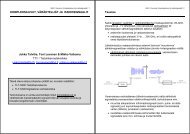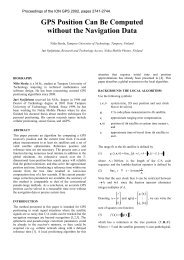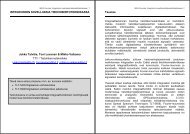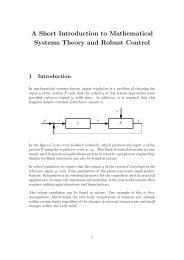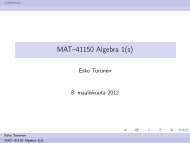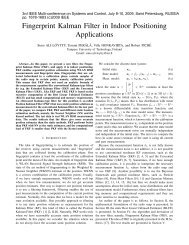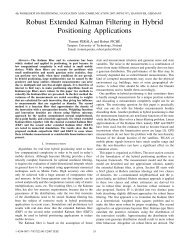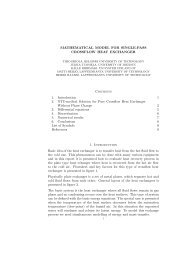Antti Lehtinen Doppler Positioning with GPS - Matematiikan laitos
Antti Lehtinen Doppler Positioning with GPS - Matematiikan laitos
Antti Lehtinen Doppler Positioning with GPS - Matematiikan laitos
Create successful ePaper yourself
Turn your PDF publications into a flip-book with our unique Google optimized e-Paper software.
geometry can be reduced to a single real number. The geometrical dilution of<br />
precision value (GDOP) is defined as<br />
H <br />
T −1<br />
GDOP = trace H (3.12)<br />
where trace means the summation alongthe main diagonal of the matrix. The<br />
GDOP value can be used for estimatingthe magnitude of the positioningerror,<br />
as follows:<br />
(3.13)<br />
σn =GDOP× σρ<br />
where σn is a combined standard deviation of the solution x, y, z and ctu components,<br />
while σρ is the pseudorange measurement standard error. Besides of<br />
the GDOP, there are other useful values that can be computed from the GDOP<br />
matrix. These include position DOP, horizontal DOP, vertical DOP and time<br />
DOP [Parkinson & Spilker, p. 414].<br />
The pseudorange positioning error <strong>with</strong> a particular satellite geometry can be<br />
estimated <strong>with</strong> the formula 3.13. Accordingto [Kaplan, p. 262], the standard<br />
error σρ in pseudorange measurements is about 8 meters. According to [Kaplan,<br />
p. 270], the GDOP value is on average below 3. The equation 3.13 now shows<br />
that the positioningerror is usually below 25 meters. Thus, the positioning<br />
performance <strong>with</strong> the <strong>GPS</strong> pseudorange positioning is far better than <strong>with</strong> the<br />
Transit <strong>Doppler</strong> positioningsystem.<br />
3.5 Limitations of the <strong>GPS</strong><br />
In the previous section it was stated that the <strong>GPS</strong> has a very good positioning<br />
performance. The theory for the pseudorange positioning is well developed and<br />
relatively easy. Still, the <strong>GPS</strong> has its limitations. One of the most severe is the<br />
satellite availability. The standard <strong>GPS</strong> receivers need to measure pseudoranges<br />
to at least four satellites simultaneously, in order to solve for the position estimate.<br />
In theory, at least four satellites should be available nearly always nearly everywhere<br />
[Kaplan, p. 287]. In practise, however, there are problems. The problems<br />
usually arise in weak signal conditions. Sometimes the receiver should have<br />
many satellites in sight but there is some barrier that prevents the <strong>GPS</strong> signal<br />
from reachingthe receiver. This occurs frequently in urban areas and indoors<br />
[Syrjärinne, p. 22]. Usually the signal is received, but it is too much attenuated<br />
for the pseudorange positioning purposes.<br />
Recently, some effort has been put to resolve the satellite availability problem.<br />
Novel methods have been developed for enhancingthe positioningperformance<br />
14




